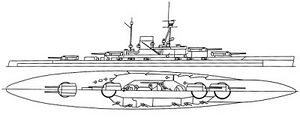Gotland-class Battleship
 Line drawing of the Gotland class battleship
| |
| Class overview | |
|---|---|
| Name: | Gotland class |
| Builders: | Isenstadt Naval Works |
| Operators: | Arcaenian Navy |
| Built: | 1918–1924 |
| Planned: | 4 |
| Completed: | 4 |
| General characteristics (as built) | |
| Type: | Fast battleship |
| Displacement: |
|
| Length: | 240 m |
| Beam: | 33.5 m |
| Draft: |
|
| Installed power: |
|
| Propulsion: | 4 shafts, 4 geared steam turbines |
| Speed: | 28 knots |
| Range: | 6,000 nautical miles (11,000 km) at 14 knots (26 km/h) |
| Complement: | 1,300 |
| Armament: |
|
| Armor: |
|
.
Design
General characteristics
Propulsion
Armament
Main battery
he primary armament of the Gotland class battleships consisted of four 42 cm SK L/45 guns mounted in four two-gun turrets in two superfiring pairs along the centerline, one pair forward and one pair aft with the aft turrets separated by the ship's engine rooms. The turrets were trained with electric motors while the guns were elevated hydraulically with each gun being capable of elevating to 30 degrees and depressing to -5 degrees. Loading the guns required them to be returned to 2.5 degrees elevation. The guns were designed to fire 1,030 kg (2,270 lb) kg projectiles at a muzzle velocity of 810 meters per second (2,700 ft/s) out to a maximum range of 36,400 m (39,800 yd) at an elevation of 30 degrees. Total ammunition stowage was 720 rounds or 90 rounds per gun with the typical shell allotment being 60 AP rounds and 30 HE rounds per gun. Rate of fire was around 2-2.5 rounds per minute per gun. The guns used a horizontal sliding wedge breech block with the propellant charge consisted of a 134 kg (295 lb) fore charge contained in a silk bag and a 128 kg (282 lb) main charge contained in a 91 kg (201 lb) brass case which acted to seal the breech.
Secondary battery
The secondary battery of the ships consisted of twelve 15 cm (5.9 in) SK L/50 guns mounted in armored casemates along the sides of the main deck and were intended for defense against torpedo boats and torpedo armed destroyers. The guns fired 46 kg (101 lb) shells at a muzzle velocity of 850 meters per second (2,800 ft/s) and were loaded with a 16.5 kg (36 lb) RPC propellant charge contained in a brass case. Each casemate had its own magazines and ammunition hoists which could supply up to 7 complete rounds per gun per minute. Each gun could depress to −7 degrees and elevate to 30 degrees with a maximum range of 17,600 m (19,200 yd) at 30 degrees elevation. Each ship was supplied with 1,920 rounds of 15 cm ammunition with 160 rounds per gun.
Anti-aircraft battery
The anti-aircraft armament of the ships consisted of eight 10.5 cm (4.1 in) L/45 Flak guns in single pedestal mounts with four guns placed around the forward conning tower and another four placed around the rear superfiring main battery turret. The gun mountings allowed depression to −10 degrees and elevation to 80 degrees. These guns fired 15.1 kg (33 lb) HE shells at a muzzle velocity of 780 meters per second (2,600 ft/s) and had a maximum range against surface targets of 15,200 m (16,600 yd) at 45 degrees elevation and a maximum AA ceiling of 103,200 m (112,900 yd) at 80 degrees elevation. The guns could also fire 14.7 kg (32 lb) illumination rounds. Rate of fire was around 15 rounds per minute and each gun was supplied with 400 rounds of ammunition.
Torpedo armament
As was typical for capital ships of the era the ships were armed with submerged torpedo tubes with two 70 cm (27.6") tubes on either beam to the rear of the engine rooms supplied with a total of 10 torpedoes. The torpedoes were the J9a type which were 9 m (30 ft) long and carried a 315 kg (694 lb) Hexanite warhead. The torpedoes used a decahydronaphthalene (decalin) wet-heater propulsion system and had a range of 18,000 m (20,000 yd) at a speed of 30 knots or 10,000 m (11,000 yd) at a speed of 36 knots.